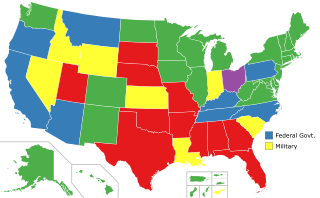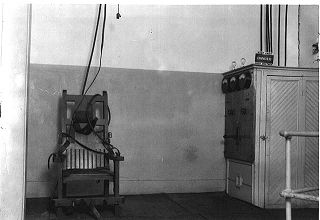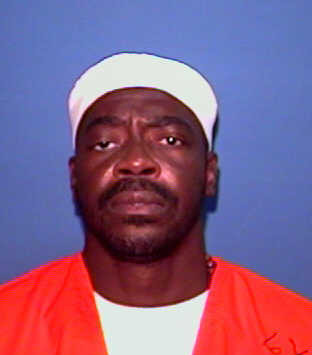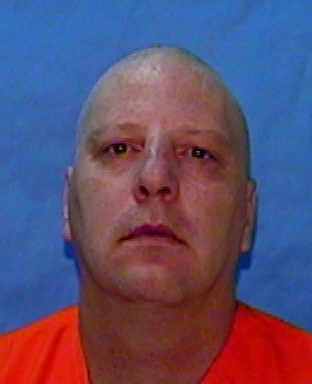
In the United States, capital punishment is a legal penalty throughout the country at the federal level, in 27 states, and in American Samoa. It is also a legal penalty for some military offenses. Capital punishment has been abolished in 23 states and in the federal capital, Washington, D.C. It is usually applied for only the most serious crimes, such as aggravated murder. Although it is a legal penalty in 27 states, 20 states have the ability to execute death sentences, with the other seven, as well as the federal government, being subject to different types of moratoriums. The existence of capital punishment in the United States can be traced to early colonial Virginia. Along with Japan, Singapore, and Taiwan, the United States is one of four advanced democracies and the only Western nation that applies the death penalty regularly. It is one of 54 countries worldwide applying it, and was the first to develop lethal injection as a method of execution, which has since been adopted by five other countries. The Philippines has since abolished executions, and Guatemala has done so for civil offenses, leaving the United States as one of four countries to still use this method. It is common practice for the condemned to be administered sedatives prior to execution, regardless of the method used.

Old Sparky is the nickname of the electric chairs in Arkansas, Connecticut, Florida, Georgia, Illinois, Kentucky, Nebraska, New York, Ohio, Oklahoma, South Carolina, Texas, Virginia, and West Virginia. Old Smokey was the nickname of the electric chairs used in New Jersey, Pennsylvania, and Tennessee. "Old Sparky" is sometimes used to refer to electric chairs in general, and not one of a specific state.
Napoleon Beazley was a convicted murderer executed by lethal injection by the State of Texas for the murder of 63-year-old businessman John Luttig in 1994.

Clarence Edward Hill was an American convicted murderer executed by the state of Florida.
Day v. McDonough, 547 U.S. 198 (2006), is a US Supreme Court case involving the one-year statute of limitations for filing habeas corpus petitions that was established by the Antiterrorism and Effective Death Penalty Act of 1996 (AEDPA). In a 5–4 decision, the Court ruled that if the government unintentionally failed to object to the filing of a petition after the AEDPA limitations period has expired, it is not an abuse of discretion for a district court to dismiss sua sponte the petition on that basis.

Samuel James "Jimmy" Ryce was a child who was abducted, raped, and killed by Juan Carlos Chavez in Redland, Florida, United States. On Wednesday, February 12, 2014, Chavez was executed at Florida State Prison in Raiford.

Mark Dean Schwab was an American murderer and child rapist. He was convicted of the April 18, 1991 rape and murder of 11-year-old Junny Rios-Martinez, Jr. and imprisoned at Raiford Prison in Florida. Schwab was convicted of the crime in 1992 and sentenced to death by lethal injection. In addition, he received two life sentences.

Ángel Nieves Díaz was a Puerto Rican convict and a suspected serial killer who was executed by lethal injection by Florida. Nieves, who had escaped from a prison in Puerto Rico while serving time for murder, was convicted of shooting and killing the manager of a strip club in Florida in 1979. He maintained his innocence until his death.
Kenneth Biros was an American convicted murderer who was sentenced to death and executed for the aggravated murder, attempted rape, aggravated robbery and felonious sexual penetration of a young woman. Biros was the first condemned person to be executed by lethal injection in the United States with the use of a single drug, setting a Guinness World Record.
Uttecht v. Brown, 551 U.S. 1 (2007), was a case dealing with jury selection in capital cases in which the Supreme Court of the United States held that appeals courts must defer to a trial judge’s decision on whether a potential juror would be able to overcome demur about capital punishment and be open to voting to impose a death sentence.

The Supreme Court of the United States handed down six per curiam opinions during its 2007 term, which began October 1, 2007 and concluded September 30, 2008.

John Richard Marek was an American death row inmate at Florida State Prison for the rape and murder of a woman in 1983. Marek was executed on August 19, 2009.

Martin Edward Grossman was convicted of first degree murder for his part in the December 13, 1984, Florida killing of wildlife officer Peggy Park. He was executed by lethal injection. In the days before his execution, there were a large number of appeals for clemency, ranging from petitions to pleas, as well as a request to halt the execution from Pope Benedict XVI. Grossman, a Jewish American, received strong support from national and international Jewish organizations for his death sentence to be commuted.
The Lethal Injection Secrecy Act is a statute in the US state of Georgia that was signed by the state's governor, Nathan Deal, and went into effect that July. The law makes the identities of people who prescribe drugs used in lethal injections, as well as those of the companies that produce and supply them, state secrets. It also makes the identities of prison staff who carry out executions a state secret. It has been called the strictest law of its kind in the country.
Wilson v. Sellers, 584 U.S. ___ (2018), is a United States Supreme Court case concerning whether a federal court sitting in a habeas corpus proceeding should "look through" a summary ruling to review the last reasoned decision by a state court.

Doyle Lee Hamm was an American death row inmate in Alabama, who was convicted and sentenced to death for the 1987 murder of Patrick Cunningham, whom he killed while committing a robbery. While on death row, Hamm developed lymphatic cancer, which made it difficult to impossible to achieve the venous access necessary to administer the drugs used in lethal injections. Despite months of warning by Hamm's attorney and human rights observers and a decades' long legal battle, the Alabama Department of Corrections attempted to execute Hamm on February 22, 2018. The unsuccessful execution attempt lasted nearly three hours and drew international attention. In March 2018, Hamm and the state of Alabama reached a confidential settlement, the terms of which precluded a second execution attempt, giving Hamm a de facto sentence of life in prison without the possibility of parole, although his sentence was not formally commuted. Hamm remained in prison until his death from cancer-related complications in 2021.

On March 28, 1996, Donovan Corey Parks, an American corrections officer, was murdered by two gang members in Baldwin County, Georgia. His two killers: Robert Earl Butts Jr. and Marion Wilson Jr. were executed for the crime by the state of Georgia via lethal injection, in 2018 and 2019, respectively. Wilson was the 1,500th person to be executed in the United States since capital punishment was resumed in 1976.
Nance v. Ward, 597 U.S. ___ (2022), was a United States Supreme Court case related to death row inmates' as-applied challenges to methods of execution.

Mark James Asay was an American spree killer who was executed by the state of Florida for the 1987 racially motivated murders of two men in Jacksonville, Florida. He was convicted, sentenced to death, and subsequently executed in 2017 at Florida State Prison by lethal injection. Asay's execution generated attention as it was noted by multiple news agencies that he was the first white person to be executed in Florida for killing a black person. He was also the first person to be executed in the United States using the drug etomidate.
Nelson v. Campbell, 541 U.S. 637 (2004), was a case decided by the United States Supreme Court considering whether a prisoner's appeal of proposed execution procedures was equivalent to a habeas corpus petition. The court held unanimously that an appeal of proposed execution procedures is different from a habeas corpus petition because it is not an appeal of a conviction or sentence.












